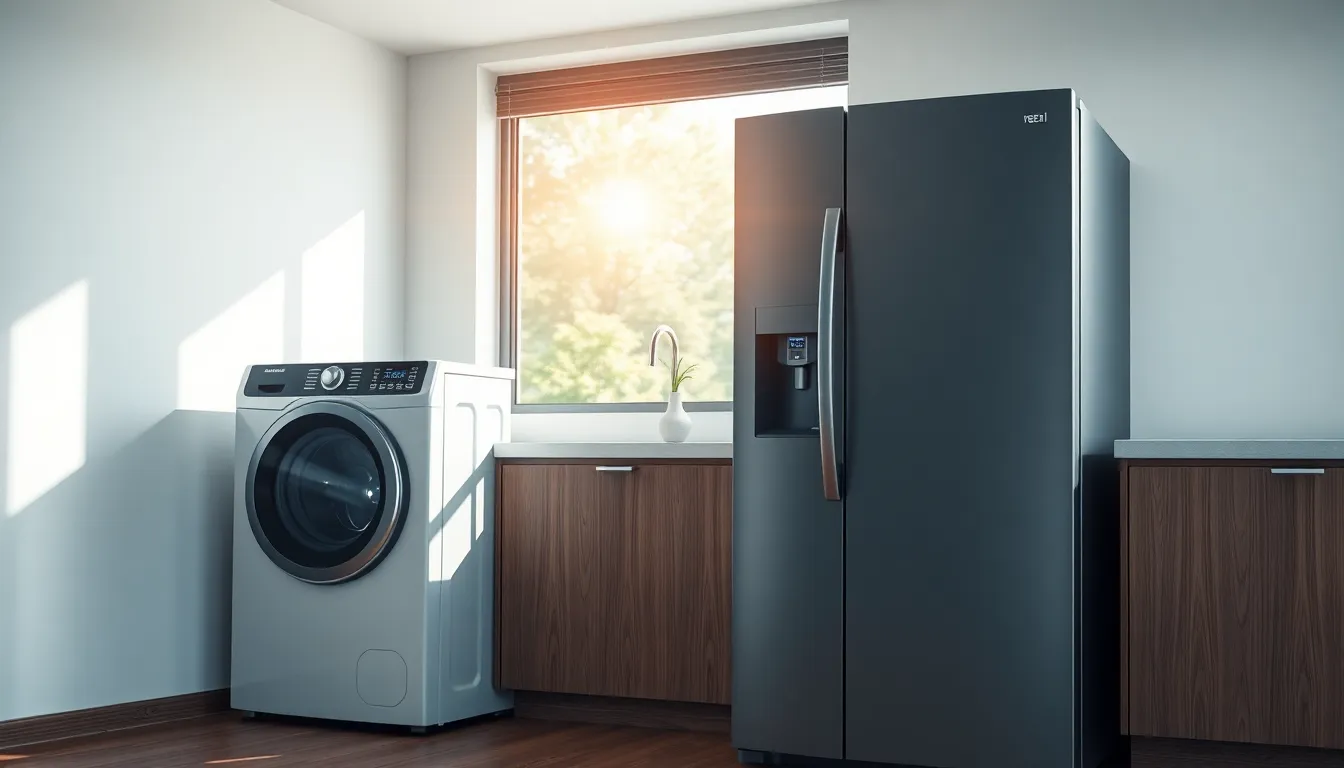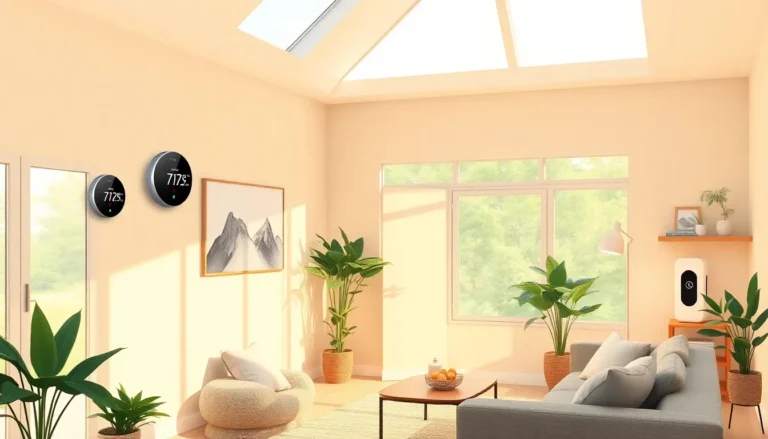In a world where energy bills can feel like a second mortgage, eco mode automation swoops in like a superhero with a green cape. It’s not just about saving the planet; it’s about saving your sanity and your wallet. Imagine your appliances working smarter, not harder, while you kick back and enjoy that extra cash for a well-deserved pizza night.
Eco mode automation takes the guesswork out of going green. By optimizing energy use, it transforms everyday routines into eco-friendly experiences. Whether it’s your thermostat adjusting itself or lights dimming when you’re not around, this tech is like having a personal assistant who’s both environmentally conscious and a little bit lazy. Who knew saving the Earth could be this easy—and amusing? Dive into the world of eco mode automation and discover how effortless it can be to embrace sustainability without sacrificing comfort.
Table of Contents
ToggleOverview of Eco Mode Automation
Eco mode automation significantly enhances energy efficiency in various appliances. This technology automatically adjusts settings to minimize power consumption during operation. Users experience reduced energy bills due to optimized energy usage. Additionally, eco mode contributes to environmental sustainability by lowering the carbon footprint associated with daily activities.
Incorporating eco mode can lead to substantial savings over time. For instance, appliances like washing machines and refrigerators often come equipped with this feature. The activation of eco mode may involve simple adjustments, such as altering temperature settings or modifying cycle lengths. It also allows for a seamless transition towards greener living without sacrificing user comfort.
Many households have reported noticeable differences in energy consumption when utilizing eco mode. Studies indicate that smart appliances utilizing automation can reduce energy consumption by up to 30%. Such statistics underscore the importance of adopting eco-friendly practices in today’s context.
Manufacturers are increasingly recognizing the demand for eco mode features. This shift aligns with a growing consumer awareness about energy efficiency and environmental impact. Eco mode automation serves as a practical answer to modern energy challenges faced by households and businesses alike.
Benefits of Eco Mode Automation

Eco mode automation offers numerous benefits, primarily in enhancing energy savings and reducing costs. This technology supports environmentally friendly practices while maintaining user comfort.
Energy Efficiency
Energy efficiency stands out as a key advantage of eco mode automation. Appliances equipped with this feature automatically adjust settings based on usage patterns. This capability reduces power consumption during periods of low demand. For instance, smart washing machines can optimize water and energy use, resulting in a more sustainable household environment. Research shows that appliances with eco mode functions can decrease energy consumption by up to 30%, effectively aiding users in achieving their sustainability goals.
Cost Savings
Cost savings represent another significant benefit of utilizing eco mode automation. Households adopting these technologies often see noticeable reductions in monthly energy bills. By minimizing power usage, eco-friendly appliances provide financial returns over time. For example, a refrigerator with an eco mode might save users hundreds of dollars annually. Many users report that the convenience of automated energy management allows for effortless contributions to their budget and the environment alike.
Applications of Eco Mode Automation
Eco mode automation showcases various applications in everyday settings. These applications significantly enhance energy efficiency while promoting eco-friendly practices.
Residential Use
In residential settings, eco mode automation plays a crucial role in optimizing energy consumption. Smart thermostats adjust heating and cooling based on occupancy, ensuring minimal energy waste. Dishwashers utilize eco modes to reduce water and energy usage during low-demand cycles. Homeowners consistently experience reduced monthly energy bills, sometimes saving hundreds annually. Moreover, refrigerators equipped with eco mode can minimize power consumption without sacrificing performance. These innovations make eco-friendly living achievable for families, enhancing both comfort and sustainability.
Commercial Use
Eco mode automation proves essential in commercial environments, driving energy efficiency in various industries. For example, smart lighting systems automatically adjust brightness based on occupancy, resulting in substantial energy savings. HVAC systems equipped with eco mode optimize performance according to occupancy levels, ensuring efficient climate control. Restaurants utilizing energy-efficient kitchen equipment report lower utility costs and improved environmental impact. Additionally, businesses often experience enhanced brand reputation due to their commitment to sustainability. Implementing eco mode in commercial operations not only promotes environmental responsibility but also leads to significant financial benefits.
Challenges in Implementing Eco Mode Automation
Implementing eco mode automation presents distinct challenges that can affect its effectiveness and user experience.
Technology Limitations
Certain technological constraints hinder the seamless operation of eco mode features. Many older appliances lack the smart capabilities necessary for energy optimization. Compatibility issues arise when integrating new technology with existing systems. Additionally, some users encounter limitations in connectivity, which impacts the automation process. Devices often require stable internet connections for optimal performance, and disruptions can lead to inefficiencies. Manufacturers must address these shortcomings by improving appliance designs and ensuring broader compatibility across various technologies.
User Adoption
User adoption of eco mode automation also faces hurdles that can influence its success. Awareness levels about the benefits of these features remain low among certain demographics. Education plays a critical role in helping users understand how to leverage eco modes effectively. Some individuals may resist changing their habits, feeling comfortable with traditional methods. Misunderstandings about operation complexity can deter users from fully embracing these technologies. Overcoming these obstacles requires strategic marketing and user-friendly interfaces that encourage proactive engagement with eco mode automation.
Future Trends in Eco Mode Automation
Advancements in eco mode automation continue to reshape energy consumption patterns. Smart appliances increasingly feature improved machine learning algorithms. These algorithms analyze user behavior, optimizing energy efficiency based on actual usage.
Furthermore, integration with smart home systems is on the rise. Devices such as smart speakers and home assistants facilitate seamless communication between appliances, allowing for coordinated energy-saving strategies. For example, smart thermostats learn preferred temperatures over time and adjust settings automatically.
Research indicates a shift towards more sustainable consumer choices. Approximately 80% of consumers express interest in green technology, pushing manufacturers to prioritize eco modes. Anticipated advancements include enhanced compatibility among devices, driving broader adoption across households and businesses.
Energy providers are also taking notice. Some utilities offer incentives for consumers embracing eco mode automation. These programs often provide rebates for purchasing energy-efficient appliances.
Moreover, the development of community-driven energy management systems is emerging. These systems allow neighborhoods to collectively reduce energy use and share resources efficiently. Data from local energy consumption can guide strategic reductions in power demand.
New regulations are being proposed, aiming to standardize eco-friendly features in appliances. Such regulations may require manufacturers to meet specific energy efficiency benchmarks. Compliance could lead to a broader market penetration of eco mode automation.
Next, stakeholders in renewable energy will likely highlight eco mode systems. By linking these technologies with solar or wind energy solutions, households can maximize clean energy use. Notably, studies show that smart appliances can reduce energy consumption by up to 30%.
Thus, eco mode automation not only supports environmental goals but also reflects consumer demand for efficiency and sustainability. The convergence of technology and environmental awareness continues to drive innovation in this sector.
Embracing eco mode automation is a step towards a more sustainable and cost-effective lifestyle. This technology not only simplifies energy management but also empowers users to contribute to environmental preservation effortlessly. As households and businesses continue to adopt smart appliances, the collective impact on energy consumption can be significant.
With advancements in technology and increasing consumer awareness, eco mode automation is poised to become a standard feature in modern living. The financial benefits and environmental responsibility it offers make it an appealing choice for anyone looking to make a positive change. As the trend grows, it’s clear that eco mode automation is more than just a convenience; it’s a vital component of a greener future.








